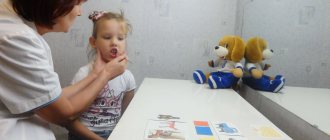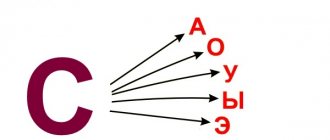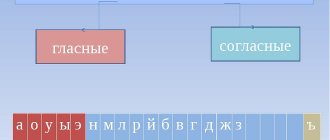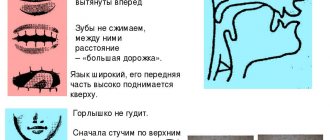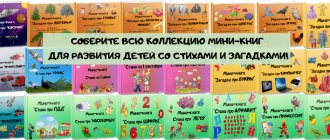Impaired pronunciation of hissing and whistling sounds in the erased form of dysarthria
With dysarthria, children experience disturbances in the pronunciation of sounds associated with:
Are you an expert in this subject area? We invite you to become the author of the Directory Working Conditions
- Their replacement. Sounds that are complex in their articulatory pronunciation are replaced by simpler ones. Whistling and hissing sounds are replaced by dull sounds.
- Mixing phonemes. They are caused by the replacement of sounds and difficulties in distinguishing the work of the organs of articulation when pronouncing a specific sound.
- Unformed pronunciation of hissing and whistling sounds.
- Inability to pronounce the consonant sound й and vowel sound ы.
- Replacing groups of sounds with diffuse articulation. As a rule, the pronunciation of two close sounds is replaced by one indistinct sound, which, in fact, is not similar to any of the given sounds. This especially affects hissing and whistling sounds.
- Different pronunciation of whistling and hissing sounds in different speech situations.
- Correct isolated pronunciation of sounds and their incorrect pronunciation in words and phrases.
Violations in the pronunciation of hissing and whistling sounds are caused by the underdevelopment of the articulatory apparatus, immaturity of articulatory motor skills, facial functions and various disorders of phonemic perception.
Finished works on a similar topic
Course work Speech therapy work with preschoolers with an erased form of dysarthria on the differentiation of whistling and hissing sounds 450 ₽ Abstract Speech therapy work with preschoolers with an erased form of dysarthria on the differentiation of whistling and hissing sounds 230 ₽ Test work Speech therapy work with preschoolers with an erased form of dysarthria on the differentiation of whistling and hissing sounds sounds 210 ₽
Receive completed work or specialist advice on your educational project Find out the cost
These disorders require the development of special directions for correction, focused on the development of articulation organs, the organization of motor functions, the development of speech rhythm and the production of specific sounds, the violation of which is the most obvious and actively manifested.
Methods and techniques for staging, automating and differentiating hissing sounds.
Methods and techniques for staging, automating and differentiating hissing sounds.
- The group of hissing sounds includes the sounds sh, zh, ch, shch
.
The sound “Ш” is a consonant, dull, hard. There is no corresponding soft sound in the Russian language.
When pronouncing the sound “Ш”, parts of the articulatory apparatus occupy the following position:
- the lips are slightly pushed forward (“window”);
- the tip of the tongue is raised to the palate (behind the alveoli), but does not touch it, forming a gap;
- the lateral edges of the tongue are pressed from the inside to the upper molars, without allowing a stream of exhaled air to pass along the sides (thus, the tongue takes the shape of a cup);
- the velum is raised;
- the vocal cords are open, the stream of exhaled air passes freely between them;
- the air stream is exhaled evenly in the middle of the tongue, it is strong, warm, and can be easily felt with the back of the hand raised to the mouth.
When pronouncing the sound “zh”, the position of the parts of the articulatory apparatus is the same as with “sh”, only the vocal cords are closed and vibrate; the tongue is raised higher towards the hard palate; the exhaled stream of air is weaker.
Articulation of sounds
and
ch
differs from the articulation of the sound
sh
by the additional rise of the middle part of the tongue towards the palate.
In addition, the sound h
is a closure-fissure, i.e., when it is articulated, the front part of the back of the tongue first closes with the alveoli, and then a gap is formed between them.
Disadvantages in the pronunciation of whistling and hissing sounds are called sigmatism.
, the replacement of whistling sounds with hissing or other sounds in the Russian language is called
parasigmatism.
Sigmatism is of the following types:
- Interdental sigmatism.
This disadvantage is expressed in the fact that when pronouncing whistling or hissing sounds (and sometimes both), the tip of the tongue is pushed between the lower and upper incisors, which results in a lisping sound.
- Labial-dental sigmatism.
With this lack of pronunciation, whistling or hissing sounds (and sometimes both) are pronounced like the sounds “f”, “v”, i.e. with such a position of the parts of the articulatory apparatus, when the lower lip is raised to the upper incisors, forming a narrowing through which the exhaled stream of air passes, and the tongue is in the position of the sound “s”. With such combined articulation, a sound is formed that contains elements of the sounds “f” and “s” (“v” and “z”), as a result of which the pronunciation becomes unclear, incomprehensible and unpleasant to the ear.
- Dental sigmatism.
This lack of pronunciation is distinguished by the fact that when pronouncing whistling sounds, the tip of the tongue rests against the edges of the upper and lower incisors, forming a barrier and interfering with the passage of air through the tooth gap, as a result of which the whistle characteristic of these sounds is absent and instead of the sounds “s, z” the sounds “s” are heard. t, d" (for example, soup - "tup", airplane - "tamolet").
- Hissing sigmatism.
With this type of sigmatism, sounds are pronounced in the following position of the tongue: its tip is pulled away from the lower incisors deep into the oral cavity, the back is sharply curved towards the hard palate, as a result of which, instead of a whistle, a softened “sh” or “zh” is heard (dog - “shabaka” , castle - “zhamok”).
- Lateral sigmatism.
With this deficiency, whistling or hissing sounds (sometimes both) can be pronounced in two ways:
a) the tip of the tongue rests on the alveoli, and the entire tongue lies on its edge; one of its edges rises to the inside of the molars, passing exhaled air along the lateral edges of the tongue, resulting in a “squelching” sound;
b) the tip of the tongue rests on the upper alveoli, passing air along the sides, as with the sound “l”.
Lateral sigmatism can be unilateral or bilateral.
- Nasal synmatism.
With this deficiency, whistling or hissing sounds (sometimes both) are pronounced in the following position of the tongue: its root rises and adjoins the soft palate, which descends and forms a passage for exhaled air through the nose, which is why a sound similar to “x” is heard, but with a nasal undertone.
Any work on correcting sound pronunciation begins with developing correct articulation. To produce hissing sounds, the following set of articulation exercises is practiced:
1. Punish the naughty tongue.
Goal: to develop the ability, by relaxing the muscles of the tongue, to hold it wide and spread out.
Description: open your mouth slightly, calmly place your tongue on your lower lip and, smacking it with your lips, pronounce the sounds five-five-five... Keep your wide tongue in a calm position, with your mouth open, counting from one to five to ten. Attention! 1. The lower lip should not be tucked in or pulled over the lower teeth. 2. The tongue should be wide, its edges touching the corners of the mouth. 3. You need to pat your tongue with your lips several times in one exhalation. Make sure that the child does not hold back the exhaled air. You can check the implementation like this: bring the cotton wool to the child’s mouth; if he does the exercise correctly, it will deviate. At the same time, this exercise promotes the development of a directed air stream. 2. Make the language broad.
Goal: to develop the ability to hold the tongue in a calm, relaxed position.
Description: smile, open your mouth slightly, place the wide front edge of your tongue on your lower lip. Hold it in this position for a count of one to five to ten. Attention! 1. Do not stretch your lips into a strong smile so that there is no tension. 2. Make sure that the lower lip does not curl up. 3. Do not stick your tongue out too far; it should only cover your lower lip. 4. The lateral edges of the tongue should touch the corners of the mouth. 3. Glue on some candy.
Goal: strengthen the muscles of the tongue and practice lifting the tongue upward.
Description: Place the wide tip of your tongue on your lower lip. Place a thin piece of toffee on the very edge of your tongue and glue a piece of candy to the roof of your mouth behind your upper teeth. Attention! 1. Make sure that only the tongue works; the lower jaw must be motionless. 2. Open your mouth no wider than 1.5-2 cm. 3. If the lower jaw is involved in the movement, you can place the child’s clean index finger on the side between the molars (then it will not close the mouth). 4. The exercise must be performed at a slow pace. 4. Fungus.
Goal: to develop an upward lift of the tongue, stretching the hyoid ligament (frenulum).
Description: smile, show teeth, open your mouth slightly and, pressing your wide tongue with its entire plane to the palate, open your mouth wide. (The tongue will resemble a thin mushroom cap, and the stretched hyoid ligament will resemble its stem.) Attention! 1. Make sure your lips are in a smiling position. 2. The side edges of the tongue should be pressed equally tightly - neither half should fall down. 3. When repeating the exercise, you need to open your mouth wider. 5. Who will kick the ball further?
Goal: to produce a smooth, long-lasting, continuous air stream running in the middle of the tongue.
Description: smile, place the wide front edge of the tongue on the lower lip and, as if pronouncing the sound f for a long time, blow the cotton wool onto the opposite edge of the table. Attention! 1. The lower lip should not be pulled over the lower teeth. 2. You can’t puff out your cheeks. 3. Make sure that the child pronounces the sound f and not the sound x, i.e. so that the air stream is narrow and not diffuse. 6. Delicious jam.
Goal: to develop an upward movement of the wide front part of the tongue and a position of the tongue close to the shape of a cup, which it takes when pronouncing hissing sounds.
Description: open your mouth slightly and lick your upper lip with the wide front edge of your tongue, moving your tongue from top to bottom, but not from side to side. Attention! 1. Make sure that only the tongue works, and the lower jaw does not help, does not “pull” the tongue upward - it should be motionless (you can hold it with your finger). 2. The tongue should be wide, its lateral edges touching the corners of the mouth. 3. If the exercise does not work, you need to return to the exercise “Punish a naughty tongue.” As soon as the tongue becomes spread out, you need to lift it up and wrap it over the upper lip. 7. Accordion.
Goal: strengthen the muscles of the tongue, stretch the hypoglossal ligament (frenulum).
Description: smile, open your mouth slightly, stick your tongue to the roof of your mouth and, without lowering your tongue, close and open your mouth (just as the bellows of an accordion stretch, so does the hyoid frenulum stretch). The lips are in a smiling position. When repeating the exercise, you should try to open your mouth wider and wider and keep your tongue in the upper position longer. Attention! 1. Make sure that when you open your mouth, your lips are motionless. 2. Open and close your mouth, holding it in each position for a count of three to ten. 3. Make sure that when you open your mouth, one side of the tongue does not sag. 8. Focus.
Goal: to develop the ability to lift the tongue upward, the ability to shape the tongue into a ladle and direct the air stream in the middle of the tongue. Description: smile, open your mouth slightly, place the wide front edge of the tongue on the upper lip so that its side edges are pressed and there is a groove in the middle of the tongue, and blow off the cotton wool placed on the tip of the nose. The air should go in the middle of the tongue, then the fleece will fly up. Attention! 1. Make sure that the lower jaw is motionless. 2. The lateral edges of the tongue should be pressed against the upper lip; a gap is formed in the middle into which an air stream flows. If this doesn't work, you can hold your tongue slightly. 3. The lower lip should not be tucked in or pulled over the lower teeth.
There are several ways to make hissing sounds:
- By imitation (imitation),
- With mechanical assistance (speech therapy probe or using the finger of a child or adult),
- Mixed (the first method, supplemented by the second).
To correct sigmatism, various methods can be used depending on the nature of the deficiency.
| Types of violations | Staging technique | |
| whistling sounds | hissing sounds | |
| I. Interdental sigmatism | 1. By imitation. 2. With mechanical assistance, using a match or duck probe, push the tip of the tongue behind the lower incisors 3. Singing [t'] | 1. By imitation. 2. With mechanical assistance, using a “frame” probe, lift the tip of the tongue to the alveoli. 3. From the articulation exercise “Cup”. Instructions: place the “cup” in your mouth without spilling the tea. 4. From English [t] with closed teeth and lips extended forward. 5. From [r], stopping the vibration and stretching the lips forward like a tube |
| II. Lateral sigmatism | 1. Through interdental pronunciation. Further see: 1.2; 1.3 | 1. Through interdental pronunciation. Further see: 1.3; 1.4; 1.5 |
| III.Nasal sigmatism | 1. From [f] with the tongue positioned between the lower lip and upper incisors. 2. Say [s] with the wings of the nose pinched. 3. Through interdental pronunciation | 1. Say [sh] with the wings of the nose pinched. Through interdental pronunciation |
| IV. Labiodental parasigmatism | 1. Perform the articulation exercise “Fence”, pronounce the sound [s], holding your lower lip. 2. Singing [t] | Pronounce the sound [sh], stretching your lips forward and holding your lower lip |
| V. Dental parasigmatism | 1. Through interdental pronunciation. 2. With mechanical assistance (see 1.2) | 1. Through interdental pronunciation. 2. With mechanical assistance |
| VI. a) Hissing parasigmatism b) Whistling parasigmatism | 1. With mechanical assistance (see 2.2. Through interdental pronunciation of the sound [f] - | — With mechanical assistance (see 1.2) |
Sequence of sound fixation:
in isolation
in syllables
in words
in sentences
in short texts.
There are some features of automating sounds for certain pronunciation defects:
a) thus, when the lateral sigmatism of both whistling and hissing sounds is eliminated, automation in syllables begins with the interdental position of the tip of the tongue, and only when it stops deviating is the tongue transferred to the interdental position.
b) with labiodental sigmatism: the sound is fixed using mechanical assistance (holding the lower lip with a finger).
With sigmatism, work on sound ends with the stage of automation - due to the absence of replacements or mixtures of the desired sound. With parasigmatism, work on sound ends with the stage of differentiating the desired sound with a substitute sound (first by ear, and then in pronunciation).
Since hissing sounds are pronounced with a tense exhalation, at the first stages of training it is useful to play games that develop breathing (choosing those that require a strong and quick exhalation), and other games, such as: 1) “The forest is noisy.” Children in a circle sway and say: shhh... It’s good to show a picture of the forest, and it’s even better to do this while walking in the forest. 2) “The bubble burst.” Children first “inflate” the bubble (spread the circle), and then squat down, squeeze into a ball with a hiss: shhh... 3) “Chickens.” Children chase away the “chickens” (blowing away pieces of paper) from the table, from the palm of their hand with the sound: ksh-ksh-ksh... 4) “Lulling.” Children rock the dolls: sh-sh-sh... 5) “Train”. Depicting a moving train, children say: shhh, and when stopping, spreading their arms to the sides, they let off steam with the sound sss.. 6) “Bees.” “Bees” are circling around a child with a flower in his hand and buzzing: w-w-w-w... 7) “Snake”. Children take turns drawing cards from the deck offered to them. Whoever draws out a card with a snake (the rest - without pictures) is a “snake” and must hiss correctly in snake style 5-10 times: shhh... “Whoever guesses (prompts) the word first.” The teacher makes a riddle, pronouncing first the syllables with the sound sh
Children in a circle sway and say: shhh... It’s good to show a picture of the forest, and it’s even better to do this while walking in the forest. 2) “The bubble burst.” Children first “inflate” the bubble (spread the circle), and then squat down, squeeze into a ball with a hiss: shhh... 3) “Chickens.” Children chase away the “chickens” (blowing away pieces of paper) from the table, from the palm of their hand with the sound: ksh-ksh-ksh... 4) “Lulling.” Children rock the dolls: sh-sh-sh... 5) “Train”. Depicting a moving train, children say: shhh, and when stopping, spreading their arms to the sides, they let off steam with the sound sss.. 6) “Bees.” “Bees” are circling around a child with a flower in his hand and buzzing: w-w-w-w... 7) “Snake”. Children take turns drawing cards from the deck offered to them. Whoever draws out a card with a snake (the rest - without pictures) is a “snake” and must hiss correctly in snake style 5-10 times: shhh... “Whoever guesses (prompts) the word first.” The teacher makes a riddle, pronouncing first the syllables with the sound sh
, and the children finish, then the roles change (shu-ba, hat-ka);
then the sound sh
is already in the second syllable (ka-sha, my-shi).
The stage of sound automation can be started only after the child has learned to correctly pronounce an isolated sound.
Automation of the sound “sh” in an open syllable (consonant + vowel)
Pronounce syllables.
sha - sho - shu shi - she - sha sho - shu - sha shu - shi - sha shu - sho - sha she - shi - sho
Say the words.
1. With stressed syllables.
Sha: step, ball, scarf, puck, hat, mine, little mice, big, earflaps, interfere, decide, breathe, horse, chess, noodles.
Sho, she: rustle, bag, fluff, top, pot, cockerel, strap, comb, big, mouse, walked, silk, whisper, left, found, came, entered.
Shi: wide, awl, tire, sew, screen, breathe, ruffs, write, reeds, kids, bruise, mistake, car, jug, sewed, decided.
Shu, she: noise, jester, fur coat, joke, bear, breathing, wearing, carcass, asking, neck, target, collar, decision.
2. With unstressed syllables.
Sha: yours, ours, porridge, roof, Dasha, Masha, Lesha, Pasha, Misha, Alyosha, Natasha, Andryusha.
Shu, shi: screw, joke, scales, overcoat, hiss, wide, briar, ears, mice, galoshes, lilies of the valley, good, pea, junior, silence.
3. With a combination of consonants in a syllable.
Seamstress, seams, closet, box, school, schoolboy, skin, went, slag, hose, helmet, went, boat, hat, bumblebee, schnitzel, lace, sleepers, twine, spy, spire, headquarters, stamp, darn, curtain, corkscrew, thing, steering wheel, bayonet.
Say sentences.
Natasha writes. Here is Masha. Masha has a hat. Lesha has lilies of the valley. Lilies of the valley are good. Misha and Pasha are riding a horse. There are reeds by the river. The river is wide. The kids are walking to school. The school is big. Misha found a pebble. A car is making noise on the road. Rose hips have thorns. The thorns are prickly. There are five children in the hut. Pasha and Natasha, please don’t make noise. Good fish soup made from ruffs. Grisha and Misha are chasing the puck. Lesha ate millet porridge. A mind is good, but two are better. Being a guest is good, but being at home is better. Further into the forest there is more firewood.
Pronounce texts.
Nursery rhymes.
Cockerel, cockerel, give Masha the comb!
We feed our Masha. Masha, Masha, eat your porridge.
Hush, mice, hush, mice! The cat came to our roof.
Naughty Misha.
Misha is a naughty guy. Playing naughty with the kitten. The kitten meowed. Grandma took the kitten away. Misha went into the forest. I saw the bump and threw my hat. I didn’t hit the cone, but the hat hung on the branch. No bump, no cap. So Misha went home.
Lilies of the valley.
Lilies of the valley love the shade under oak trees. You will come to a place where there are lilies of the valley. Lilies of the valley are visible and invisible. And in the unmown meadow there are daisies and peas. Nearby, by the river, there are reeds. The wind sways the reeds. They rustle, breaking the silence. Pick lilies of the valley and go home. Nice lilies of the valley!
After mastering the sound sh
zh
is acquired in the same way . To do this, play games to imitate beetles, bees, and flies on onomatopoeia:
1. “bees” are buzzing around the “flower” (the child is holding a flower in his hands);
2. “flies” are buzzing in the “web” (trying to “break out” of the circle formed by the children). 3. Dramatization on the topic: “The beetle has fallen and cannot get up, he is waiting for someone to help him.” One of the children catches beetles with a net, and they fly and buzz. Whoever the net falls on falls on his back, moves his arms and legs - he cannot get up, he “buzzes” until all those caught are collected (lifted), turning them over on their stomachs. When the sound is learned
, then it is useful to compare it with the already firmly acquired sound
w
, and then with
z
.
sh - z
are transmitted in turn ).
The words ball - heat, awl - vein are used. Mom dress... (sewed). I am with my grandmother... (lived). Misha asked Zhenya: “Do snakes have ears?” What did Zhenya answer? "Snakes have ears." Zhura and Shura will be with their grandmother in the summer... (to live). Shura and Zhura will collect ... (acorns) under the oak tree. They make ... (boots) from goat skin. After this, a game is played to invent words with the same sounds. Then children learn short tongue twisters with the sounds sh
and
z
.
(A hat and a fur coat - that’s our Mishutka. It’s terrible for a beetle to live on a bitch.) Next, they learn riddles that have already been guessed before, and new ones: A loaf of bread hangs above the grandmother’s hut. (Moon.) Sits on the roof of everyone higher, breathing smoke. (Trumpet.) The training ends with games in which children use coherent speech, memorizing rhymes and songs, in the text of which the studied sounds are often found. These sounds are well learned in the game “Bazaar”. Sample games for reinforcing learned sounds. 1. "Silence." The children tiptoe around Masha, who is writing, and quietly say: “Hush, hush, Masha is writing, Masha is writing a long letter.” 2. “Cat on the Roof.” The child in the role of a cat sits (sleeps) on a bench, on a chair or on a table. Holding hands, the mice carefully walk around the cat and quietly say: “Hush, mice, the cat is sleeping on our roof!” Then, turning to each other: “Mouse, mouse, be careful, don’t get caught in the cat’s mouth.” The “cat” wakes up and, shouting “meow,” rushes at the mice. The mice run away into the “hole,” that is, to their places. The cat catches those who pronounce the sh
.
The person caught must say five words with this sound. 3. "Beetle". An introductory talk about beetles is given. The teacher says where beetles live (according to the seasons). Then the game begins. Standing in place, children simultaneously smoothly wave their arms, rhythmically step their feet, and say: “I am a beetle, I am a beetle” (twice); hands with mouthpiece to mouth: “Buzzing, buzzing”; full turn with arms extended to the side: “I’m circling, circling”; palms on chest: “I’m sitting on a leaf”; hands on hips, bold posture: “And I don’t push, and I don’t push!” Wave your arms up and jump: “I’m a beetle!” Teacher: “Let’s fly!” The guys make small flying movements with their hands and quickly run in small steps in different directions: zhzh... It’s good to play this game with music or marching. 4. “Who will win more?” 10-12 toys are selected, the names of which include the sounds sh
and
z
, and the corresponding number of drawings on the cards and the same number of “dummies” (cards without drawings).
Children take out cards one by one and, calling out the picture loudly, take the corresponding toy. Taking out the “pacifier”, the child says: “Nothing, pacifier.” The toy is received subject to the correct pronunciation of w
and
w
.
5. Game “What is this?” Children feel a toy or thing hidden in a bag, name and show it (bear, hat, ball, mouse). 6. “Fly in a web.” The “fly” child runs around in a circle of children and buzzes, trying to escape from the circle (web). 7. "Collecting fruits." There are 10-20 pictures drawn on a large map (cherries, sweet cherries, gooseberries, blackberries, pears, rose hips, acorns, nuts, eggplant). Children take turns throwing a cube on the table, on the sides of which there are “points” from 1 to 6. Whatever number is on the top side of the cube, the player’s piece moves on the map by the number of cells. He loudly pronounces the name of the picture on which he places his chip. Whose chip comes first to the last picture (upper left corner of the card), depicting a pile of different vegetables, wins. The loser, at the direction of the winner, names 3 pictures from this game three times. 8. “A trip to Shuvalovo.” Children turn to the cashier with the words: “Please give me a ticket for train No. 6 to Shuvalovo station.” Controller: “Allow me, your ticket.” To reinforce the correct pronunciation of sounds, children memorize poems and riddles, for example: 1) Poor Bear got sick - Bear ate a lot of honey. The bear cries and shouts: “My stomach hurts!” 2) I sewed a shirt for Mishka, I sewed new pants, I need to sew a pocket on them and put some candy. 3) The rain fell and passed, the sun is shining brightly. This is very good for both adults and children. 4) A tiny boy in a gray army jacket scurries around the yards, collecting crumbs. (Sparrow.) 5) He is friends with the owner, guards the house, lives under the porch, and has a tail like a ring. (Dog.) After children have mastered the sounds w and w,
ch and sh using
similar techniques .
They start with exercises to distinguish sounds by hearing (ball - mother, sing - stove, stove - Petka, lie down - bream, bangs - lye). This is followed by: 1. Games: a) “Train” (ch-ch-ch), and then: choo-chu-chu; b) Word game: cha-sy, tea-nick, chu-lock, chash-ka, tu-cha, shoulder-cho, ball-ch, key-chi; c) “Cat and Mice.” The mice, running away from the cat, say: “I’ll run away from the cat, I want to live, I want, I want!” 2) Nursery rhymes. Chi-chi-chi, chi-chi-chi, baked rolls in a hot oven. The rolls are hot, very, very good! Ai, choo-choo, choo-choo, choo-choo! I'm riding the train! (Can be used in the game "Train".) 3. Rhymes. Our Tanya is crying loudly: She dropped a ball into the river. “Hush, Tanechka, don’t cry - the ball won’t drown in the river.” 4. Counting books. Chok-chok... The heel hit a twig. It came off, it broke, Chock-Chock, Heel! Fix this heel for me, Old Man. Sample texts for pronouncing the sound ь and differentiation with the sound h
. 1. "Puppies." Two puppies are brushing a brush in the corner, cheek to cheek. Yes, the brush has a stick above its head. The stick clicked the puppies from the shoulder, two puppies left grumbling. 2. I’ll quickly list to you what I clean with each brush. I clean my dress with this brush, I clean my shoes with this brush, I won’t forget this one, I brush my teeth in the morning. In this case, the so-called brushes or their designs are shown. 3. Don't scream or eat, look for a worm. And under the old brick, you and I will look together. 4. The watchmaker, squinting his eye, repairs the watch for us. 5. Bobka and I landed in the mud. They put me in the bathtub. And now the brushes, the brushes Crackled like rattles, And let’s rub me, Saying: “My, my chimney sweep Clean, clean, clean! It will be, it will be a chimney sweep. Clean, clean, clean, clean!” 6. Gray, toothy, prowls the fields, looking for calves and lambs. (Wolf.)
After mastering the entire group of hissing sounds, children practice differentiating them in the following games and fun. Children must distinguish sh - s, zh - z, ch - sh, ch - th, sha - zha, shu - zhu
:
cone - sausage, beetle - tooth, stove - Petka, cat - hummock, ball - heat, Zhurka - Shurka, etc.
The following games are recommended:
1. Game “Who hears better.” sounds are pronounced alternately
and
h
, imitating a beetle and a mosquito. Children guess whose buzzing it is.
2. The game “Who loves Shurka, who loves Zhurka.” The teacher tells an impromptu fairy tale about two brothers Shurka and Zhurka, one of whom, suffering from excessive curiosity, poked his nose everywhere, which extended into a beak; he himself turned into the crane Zhurka and began to live in the swamp. Children are divided into two groups - supporters of Shurka and Zhurka and clap their hands when they hear the name of their hero.
3. Game “Tell me what’s missing” - in the second word spoken by the teacher, a sound or syllable is skipped (hat - apka, Bear - Mika) 4. “Train”. Depicting the movement of a train, children move around the room to the rhythm of the march and pronounce the sounds: 1) fast train (“arrow”) - w; 2) postal - h; 3) commodity - w; 4) mixed - w. When stopping, the “locomotive” releases steam (sound s), and then all the children slow down (sound s). Signals are given by the leader or one of the children (whistle - trrr...), the “locomotive” (or everyone) makes a whistle: ooooh. The first in the row (“locomotive”) makes puffing sounds (sh, sch, ch), and the “cars” reproduce the rhythm of the wheels: ta-ta-ta, ta-ta-ta or da-da-da, da-da-da . The teacher sings the song “The Train is Rushing,” and the children, imitating the movement of the “train,” rhythmically say: che-sha-sha-sha or sing along with the teacher. As a result of this game, children sing the entire song while the train is running. It is very good to conduct it with music (not very loud). — Game option for the older group: — Wow, that’s hard. ..- repeats the “steam locomotive”, slowly moving away from the “station”.- Well, then!..- the “cars” repeat after him many times.- Wow, it’s getting hot!..- the “steam locomotive” accelerates.- A What do we care! - the cars rumble. - Oh, how scary!.. - the locomotive slowly passes along the “bridge” (a conventional place marked with chalk, a rug, etc.). - So be quiet!.. - “cars” (scared). - Now it’s gone!..- “locomotive” (having passed the “bridge” and accelerating its run).- That’s how it went!..- “carriages” (joyfully). It is necessary to ensure that children clearly imitate the rhythm of the train. In all these games, “faulty” cars are “uncoupled” and taken away after the “repair” game, i.e., to correct the sound. It is entertaining and useful for children to pronounce phrases that are difficult to differentiate: Sasha has soot on his nose; A rat is running on the roof. This difficulty is alleviated by showing appropriate pictures.
